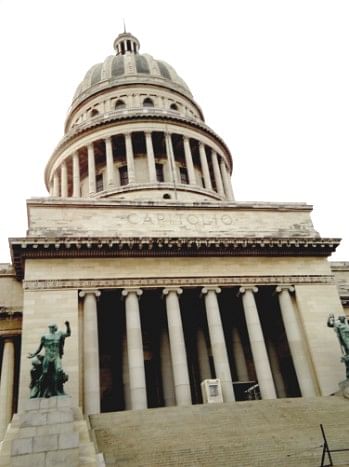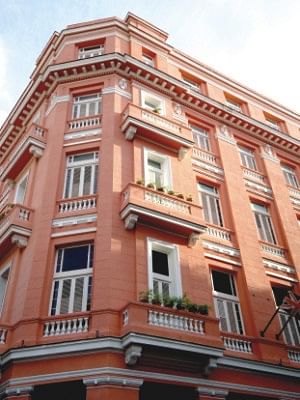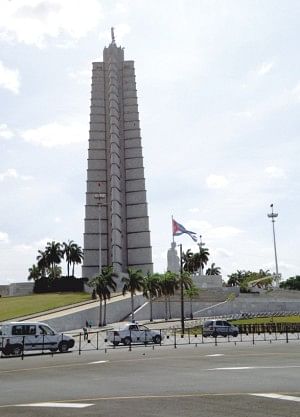| Home - Back Issues - The Team - Contact Us |
 |
| Volume 10 |Issue 19 | May 20, 2011 | |
|
|
Travel Three Days in La Habana Akhtar Sultana Cuba will not be on top of the tourist list for most people from our part of the world. But it is a very popular tourist destination for Canadians. My husband, Sajjad and I decided to visit Cuba and we are glad that we did.
Our plane landed in Varadero Int. Airport at 9.30 pm. After clearing immigration and claiming our luggage we headed for La Habana which is 140 km east of Varadero. The cab sped through the deserted road and we reached Hotel Panorama only in an hour and a half. On our way, we passed the city of Matanzas. The story goes that in the 16th century, when the Spanish ship reached the port, the natives welcomed the Spaniards with fruits, vegetables and animals as offerings for friendship. In return for the hospitality, the Spaniards butchered all the natives, hence the name Matanzas which in Spanish means massacre. The next day we took a guided tour of Havana. We drove through a long stretch of road alongside of the Gulf of Mexico with its deep aquamarine waters. The bus dropped us off at Old Havana, which has been declared Heritage Sites by the UNESCO. A lot of restoration works are being done to preserve and restore the grandeur of old Havana. The architecture reflects the Moorish, Spanish, Roman, Greek and Italian influence and style. Led by our guide, Elisha we started down the well laid narrow straight roads, cutting each other at right angles. A lot of these roads are closed to traffic and are full of open-air restaurants with band playing lively music. We walked around the Cathedral Square where the famous Cathedral of Saint Christopher, built in the 18th century and dedicated to Saint Christopher stands. It is a classic Baroque church with interiors covered with religious art. The cathedral is full of columns and niches and has asymmetrical features with one tower wider than the other. The interior of the church is stunning with beautiful frescoes of the saints. The plaza around the cathedral is a lively place, which now houses open air restaurants and bars full of tourists. Hemmingway's famous novel The Old Man and the Sea which helped him win the Nobel Prize for Literature in 1954 was written in Havana. His hotel, his home and the bars he frequented are now tourist spots. As fans of his writings, it was natural for us to visits those places. First we went to the La Bodeguita, which was frequented by the writer where he enjoyed the famous Cuban rum based drink called mohito. A little away from the Cathedral, is the bar, El Floridita, which was also, frequented by Hemmingway every evening to enjoy the drink, daiquiri which some say was his invention. Next we walked through the narrow roads and passed the five-storey, pink Ambos Mundo Hotel. It is said that it was in Room 511 of this hotel that Hemmingway was inspired to write the novel For Whom the Bell Tolls. The room and his house have now been turned into a museum.
Many of Havana's old mansions have been turned into museums. The Museum of the City, which was the Palace of the Captain General, is a magnificent building of the 18th century Cuban baroque architecture. Overlooking the courtyard is the white marble statue of Christopher Columbus. The museum displays relics from the colonial period and of course, there is the Throne Room, which was used by the Spanish Monarchs when they visited Cuba. A Russian tank used in the Bay of Pigs stands in the plaza outside the museum. We strolled along the Plaza de Armas, which was full of open air bookstalls. Further down, was the road laid out with wooden tiles leading to the palace of the governor. The story goes that when horses trotted down the road, the noise disturbed the governor's sleep who ordered that cobble stones of the roads be replaced by wooden tiles- thereby making less noise so that he could sleep peacefully. Our next stop was the Revolution Square, which includes the Jose Marti Memorial, the Ministry of Interior and the National Library. The Jose Marti Memorial, dedicated to the famous 19th century Cuban intellectual and revolutionary, is located on the northern side of the Plaza. Among its distinctive features, is a 358 ft. high star shaped tower and a 59 ft. tall, white marble statue of Jose Marti surrounded by six columns, a fitting tribute to the inspiration of the Cuban Revolution. Right across Jose Marti's statue, a few hundred yards away is the building that houses the Ministry of Interior with the mural of Che Gueverra cast in iron. Che Gueverra is revered in Cuba and was also the first interior minister appointed by Castro. On the eastern side is the National Library. We visited the National Capitol Building or El Capitolio, built in 1929 and fashioned after the United States capitol in Washington DC. The huge 300 feet high dome definitely bears a resemblance to United States capitol. It used to be the parliament till the Cuban Revolution in 1959 and is now the Cuban Academy of Sciences. Our next stop was the cigar and rum factory. Cuban cigars are world famous as is their rum. As we were about to board our bus, our eyes caught a verse from the Quran on the walls of a house. Next to it was the owner's name. In a country, where majority are atheists and the rest Catholics, I thought it was interesting that the owner of the house was quite bold and explicit in showing his faith.
The highlight of our city tour was the nearly one hour-long catamaran ride in the Gulf of Mexico. With cool breeze from the sea on our faces and sipping rum and cola, we sailed along the old fort, passed the 66 ft. tall statue of Christ, went passed the front of the old fort and turned around, thus ending our catamaran ride. What a perfect way to end a hot and tiring day-tour. The next day Sajjad and I went gallivanting old Havana by ourselves. The hotel shuttle bus dropped us at the old Havana and we set out on foot to explore the old part of the city. It made us nostalgic to see the vintage cars of the 1950s and 1960s, the Chevrolets, Impalas and Fords running as taxis in the streets of Havana. We visited the small handicraft stores by the side of the road, bought few souvenirs, went into the Museum of Colonial Art, walked on the Malecon, a broad esplanade which is 8 km starting from the mouth of Havana Harbour in Old Havana to Vedado. The weather was warm and we watched fishermen fishing and had lunch in a small restaurant on the esplanade beside the water. We did not find a single statue or portrait of Castro anywhere in Havana but surprisingly we came across the bust of Rabindranath Tagore and Kemal Ataturk in front of the children's park. On our last evening in Havana we decided to go Castillo del Morro to watch the famous 9 pm cannon shot. In the olden days, the cannon shot signified the closing of the gates of the fort. The fort was built at the mouth of the bay, 60 metres above the sea in the 16th century to guard the city from the pirates and invaders. The hour long ceremony begins at 8 p.m. when the soldiers dressed in the Spanish uniform worn during the colonial times play the bugle and beat drums. Around 8.15, two soldiers march up where the cannon rests and start the process of getting the cannon ready. At 8.45 pm, a small band playing the bugle and beating drums, march along the pathway up the stairs to the post and take their position around the cannon. After the cannon has been readied, one soldier marches up to the captain to report to him. The captain at the stroke of 9 brings down his sword, signalling the firing of the canon. A huge deafening blast follows and the troop marches down. This is followed by a carnival, parading along the path of the fort, dancing in colourful clothes, with tourists joining in, dancing to the tune of the music. After three wonderful and exciting days in Havana we left for the beach resort of Varadero. I had gone to Cuba with a good measure of apprehension. This was my first visit to a socialist country. I expected a land with serious, unsmiling, regimented people but instead found a very friendly, happy go lucky and musical people. The country of Cuba and the city of Havana has a lot of history, culture and above all a safe, fun loving place. Western media's portrayal of Cuba is far from the truth. I strongly recommend a visit to this wonderful land of Castro, Che and Hemingway.
Copyright (R) thedailystar.net 2011 |


